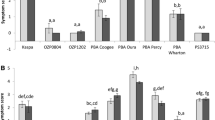Abstract
The level of genotypic variation in tolerance to low boron (B) supply was investigated in solution culture grown, 10 day old (D10) oilseed rape (Brassica napus L.) plants, by using a rapid screening technique whereby root length, root elongation rate and total root dry weight were used to indicate plant response to B. Root length proved more reliable in determining genotype responses, and was used to characterise a total of 61 genotypes, of which Huashuang 2, Nangchang rape, Huashuang 1 and Zhongyou 821, and to a lesser extent, Zheyou 2, Dunkeld, Xinza 2, Nangjin 2051, 92-58, 92-13, and Awassa 115 exhibited some form of tolerance to low B supply. The genotypic rankings based on this early vegetative response corroborated with field based B-efficiency. The results demonstrate the expression of the B-efficiency mechanism in the early vegetative stages of plant growth, and establish the value of root length as a selection criterion for B-efficiency in oilseed rape.
Similar content being viewed by others
References
Chantachume Y, Smith D, Hollamby G J, Paull J G and Rathjen A J 1995. Screening for boron tolerance in wheat (T. aestivum) by solution culture in filter paper. Plant Soil 177, 249–254.
Cohen MS and Lepper R Jr 1977. Effect of boron on cell elongation and division in squash roots. Plant Physiol. 59, 884–887.
GENSTAT Committee 1989. GENSTAT 5 reference manual. Oxford, UK. Clarendon Press.
Graham R D 1984. Breeding for nutritional characteristics in cereals. Adv. Plant Nutr. 1, 57–102.
Huang L, Ye Z and Bell R W 1996. The importance of sampling immature leaves for the diagnosis of boron deficiency in oilseed rape (Brassica napus cv. Eureka). Plant Soil 183, 187–198.
Liu Z, Zhu Q and Tang L 1981. Boron deficient soils and their distribution in China. Soil research report no. 5. Institute of Soil Science, Academia Sinica, Nanjing, China. pp 1–13.
Neales T F (1960). Some effects of boron on root growth. Aust. J. Biol. Sci. 13(3), 232–249.
Norvell W A and Welch R M 1993. Growth and nutrient uptake by barley (Hordeum vulgare L cv Herta): Studies using an-(2-Hydroxyethyl) ethylenedinitrilotrilotriacetic acid-buffered nutrient solution technique. I. Zinc ion requirements. Plant Physiol. 101, 619–625.
Odhnoff C 1957. Boron deficiency and growth. Physiol. Plant. 10, 984–1000.
Rerkasem B and Jamjod S 1997. Genotypic variation in plant response to low boron and implications for plant breeding. Plant Soil 193, 169–180.
Stangoulis J C R 1999. Genotypic variation in oilseed rape to low boron nutrition and the mechanism of boron efficiency. PhD thesis, University of Adelaide.
Stangoulis J C R, Grewal H S, Bell R W and Graham R D 2000. Boron efficiency in oilseed rape: I. Genotypic variation demonstrated in field and pot grown Brassica napus L. and Brassica juncea L. Plant Soil. 225, 243–251.
Warington K 1923. The effect of boric acid and borax on the broad bean and certain other plants. Ann. Bot. 37, 629–672.
Whittington W J 1958. The role of boron in plant growth. II. The effect on growth of the radicle. J. Exp. Bot. 10(28), 93–103.
Xue J, Lin M, Bell R W, Graham R D, Yang X and Yang Y 1998. Differential response of oilseed rape (Brassica napus L.) cultivars to low boron supply. Plant Soil 204, 155–163.
Yang Y, Xue J, Ye Z and Wang K 1993a. Responses of rape genotypes to boron application. Plant Soil 156, 321–324.
Yang Y, Xue J, Ye Z and Wang K 1993b. Management of B and Zn in oilseed crops in China. Annual Report of ACIAR project 9120. pp 231–237.
Zarcinas B A, Cartwright B and Spouncer L R 1987. Nitric acid digestion and multi-element analysis of plant material by inductively coupled plasma spectrometry. Comm. Soil Sci. Plant Anal. 18, 131–146
Author information
Authors and Affiliations
Rights and permissions
About this article
Cite this article
Stangoulis, J.C.R., Webb, M.J. & Graham, R.D. Boron efficiency in oilseed rape: II. Development of a rapid lab-based screening technique. Plant and Soil 225, 253–261 (2000). https://doi.org/10.1023/A:1026595012326
Issue Date:
DOI: https://doi.org/10.1023/A:1026595012326




